The name chickpea comes from the Latin word cicer, referring to the plant family of legumes, Fabaceae. It is also known by its popular Spanish-derived name, the garbanzo bean. Kidney beans, black beans, lima beans, and peanuts are other familiar foods found in this legume family. These plants produce edible seeds, called pulses, that have high nutritional value. Two main varieties of chickpeas are the larger round light-colored Kabuli-type, common in the United States, and the smaller dark irregularly shaped Desi-type often used in India and the Middle East.
Chickpeas appear in early recordings in Turkey about 3500 BCE and in France 6790 BCE. India produces the most chickpeas worldwide but they are grown in more than 50 countries. An excellent source of carbohydrate, protein, fiber, B vitamins, and some minerals, they are a nutritious staple of many diets.
Chickpeas and all pulses contain several components that, when eaten as part of a balanced plant-rich diet, may help prevent the development of various chronic diseases [1-7]
Diabetes: Both dried and canned chickpeas have a low glycemic index and low glycemic load, and contain amylose, a resistant starch that digests slowly. These factors help to prevent sudden surges in blood sugar and insulin levels, which can improve overall blood sugar control in people with type 2 diabetes. [1-3,5-7]
Gut Flora: Chickpeas contain a soluble fiber called raffinose, a type of oligosaccharide that is fermented in the colon by beneficial bacteria called Bifidobacterium. As bacteria break down this fiber, a short chain fatty acid called butyrate is produced. Butyrate plays a role in reducing inflammation in the cell wall of the colon, promoting regularity in the intestines, and possibly preventing colorectal cancer by promoting cell apoptosis (death). [1,3,4]
Heart Disease: Chickpeas contain a plant sterol called sitosterol that is structurally similar to cholesterol in the body. It interferes with the body’s absorption of cholesterol and thereby can help to lower blood cholesterol levels. The fiber and unsaturated fats in chickpeas may also favorably affect blood lipid levels. [1-3,5-7]
Obesity: High fiber foods can help to promote a feeling of fullness and satiety by delaying digestion and adding bulk to meals. The satiating effect of the high fiber and protein content of chickpeas may help with weight management. [1-3,5,7]
Did You Know?
Roasted and ground chickpeas have been used as a caffeine-free alternative to coffee for centuries. The beverage is also available as ready-to-brew commercial brands in some grocery stores.
Don’t throw out chickpea liquid, either from canned beans or from cooking the bean! It is called aquafaba, a thick liquid containing a mix of starch and trace amounts of protein, with emulsifying, binding, and thickening properties. It works well as a flavorless, odorless egg replacer in recipes: 1 tablespoon of aquafaba = 1 egg yolk, 2 tablespoons = 1 egg white, and 3 tablespoons = 1 one whole egg. It can also be whipped to replace the eggs in meringues or mayonnaise.
Unlike many canned vegetables, canned chickpeas retain much of their nutritional value and are comparable to dried cooked versions.
Hummus
A Staple In Our Diet
Put 2-3 handful of chickpeas in a bowl of water and soak overnight. Make sure there is enough water to cover the beans and then some. After soaking strain and rinse well. Place in a pot, cover the chickpeas with water and bring to a boil. Cover the cooking pot, turn the heat down and cook for 30-35 minutes.
After cooking place the chickpeas in a strainer and rinse well. After cooking and washing the skins will be eased off of the chickpeas. Pick out as many of the skins as you have patience for and discard.
Place the cooked chickpeas in a food processor. Add quality salt and fresh ground pepper to taste. Add the juice of 2 lemons. We like the sharp flavor the lemon adds to the hummus so we use 2. If you do not like this use less lemon. Add one clove of finely chopped garlic. Add a heaping tablespoon of raw tahini. Turn on the food processor and blend for a few minutes. The hummus us will probably be a bit thick. To make the hummus creamy and less thick add the secret ingredient. Which is cold water from the fridge. Place a small amount of cold water in a glass, tune the food processor on and add a small amount of the cold water. This will make a beautifully creamy hummus. Caution if you add too much cold water the hummus will be too thin and runny so add a small amount of the cold water until you achieve the consistency that you like.
Note: Organic canned chickpeas are available but we always prefer the organic raw chickpeas as the flavor of the hummus is better at least to our tastebuds.








